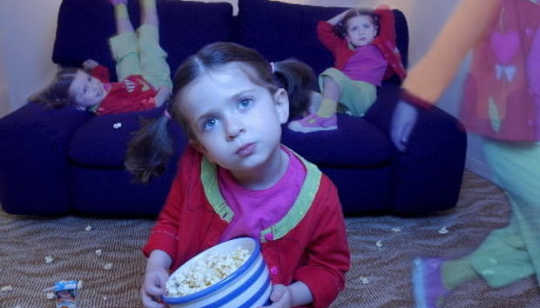
By the time they are teenagers, more than two-thirds of young people are not doing enough physical activity. Teenagers spend an average of eight hours every day sitting, with 11 to 15-year-olds watching nearly three hours of television. Most of us are well aware that such behaviour risks damaging their physical health, but there’s an additional problem. I have been involved in a new piece of research which suggests that too much screen time is also harming grades.
We measured the physical activity and sitting time of 845 teenagers at 14.5 years old, using a sensor that measures movement and heart rate. We asked how much time they spent watching TV, playing computer games, going online, doing homework and reading. And at the end of year 11, when these students were 16-years-old, we collected their GCSE results.
We found that teenagers with higher screen time had lower GCSE grades, even when we took account of differences in homework and reading. Television, computer games and internet use were all associated with poorer academic performance, but TV viewing was the most detrimental. For every hour that someone watched per day, they showed a drop of nine GCSE points in total – the equivalent of two whole grades in one subject (or for example, one grade in each of two subjects). Two extra hours was associated with 18 fewer points.
Although we did not find that more physical activity was associated with higher grades, as some other studies have suggested, it was not detrimental to academic performance either. It’s important that this message isn’t lost among the findings about screen time: schools are under so much pressure to improve exam results that many don’t prioritise PE and other opportunities for physical activity for fear that they interfere with academic achievement.
The Case For 60 A Day
The wider picture is that most teenagers are failing to meet the recommendations of doing at least 60 minutes of moderate or vigorous physical activity each day (activity that makes you sweat and breathe heavily). This needs to change if we are to develop a more rounded approach to our children’s education. Behaviours developed in the teenage years are likely to persist into adulthood, and we need to take every opportunity to improve the nation’s health by tackling high levels of physical inactivity across the population.
There are many reasons for young people not taking enough exercise, which will differ for each individual. Teenagers are often given a bad press about being lazy but I don’t believe that, and we should resist the temptation to blame them. Even as someone who studies and promotes physical activity, for example, I find it hard to fit it into my day, and it certainly wasn’t a priority for me at school.
In our research, we asked teenagers how we could help them to be more active and sit less. The overwhelming response was that they didn’t want to be sitting around, but lacked opportunities to be active in a way that interested them. They wanted more variety and choice about what activities they tried, telling us that the limited range of school sports was putting most of them off. This dislike of PE in high school could sour exercise for life. Offering a range of non-traditional activities – from martial arts to zumba – over the usual football or netball could encourage young people to take more exercise.
A related point is that while many strategies have focused on educating us about the health benefits of exercise, it looks like that doesn’t work. We need to change the way we pitch the message instead. Researchers and practitioners need to find out what motivates people and use that to convince them to be active instead. For instance one fascinating study paired adult men with Scottish football clubs for a weight loss and healthy-living intervention. The programme succeeded in encouraging this hard-to-reach group to improve their health because it tapped into these men being fans of football rather than health benefits
Be Lean With Screens
Put this all together and a win/win answer begins to emerge. So long as homework and reading time are protected, schools and parents should be looking to encourage teenagers to swap screen time for physical activity. And in a multi-screen world that teenagers navigate frequently without supervision, we will need to become more sophisticated about how we guide the amount of time they spend in front of screens and what choices they make instead. Encouraging a good variety of physical activity and tapping into what makes them tick rather than speaking endlessly about health benefits looks like a good place to start. Achieve this goal and it looks like the way to maximise academic achievement and reduce health risks at the same time.
We also need to think about what happens in future. Screens are proliferating and we’re not going to get rid of them. Nor should we want to – the worlds that young people can access through screens can educate, inform and enrich their lives, from nature documentaries to Minecraft. And with more and more activities moving online – including educational resources – there are many unanswered questions about how future generations may adapt. For now and the future, the challenge is to get teenagers more active so that once they’ve done their homework, the last thing that they think of is sitting in front of a screen.
About The Author
 Kirsten Corder is Senior Investigator Scientist at University of Cambridge. Her research predominantly focused on investigating determinants of change in physical activity in children and adolescents. She also has worked to develop the design, implementation and evaluation of a multi-component obesity intervention (Project MOVE) to improve diet and increase physical activity in children and their families.
Kirsten Corder is Senior Investigator Scientist at University of Cambridge. Her research predominantly focused on investigating determinants of change in physical activity in children and adolescents. She also has worked to develop the design, implementation and evaluation of a multi-component obesity intervention (Project MOVE) to improve diet and increase physical activity in children and their families.
This article was originally published on The Conversation. Read the original article.
Related Book:
at

Thanks for visiting InnerSelf.com, where there are 20,000+ life-altering articles promoting "New Attitudes and New Possibilities." All articles are translated into 30+ languages. Subscribe to InnerSelf Magazine, published weekly, and Marie T Russell's Daily Inspiration. InnerSelf Magazine has been published since 1985.

Thanks for visiting InnerSelf.com, where there are 20,000+ life-altering articles promoting "New Attitudes and New Possibilities." All articles are translated into 30+ languages. Subscribe to InnerSelf Magazine, published weekly, and Marie T Russell's Daily Inspiration. InnerSelf Magazine has been published since 1985.
























